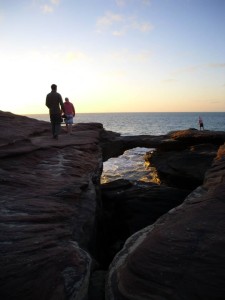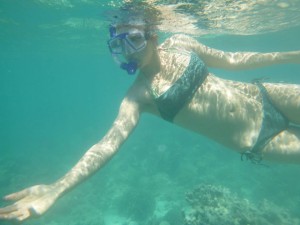I thought broken glass caused the reflections. Less than five minutes had passed since we navigated through the night to an FMG Exploration Drill Site and popped our tent up. My quest, sans contact lenses, was to visit nature’s ladies room for the last time that day.
Flashlight in hand, I took a step. The glittering pieces shifted, like a prism in the wind. Curious, I plunged deeper into the shrubs and waist-high termite mounds. I squinted into the darkness. My attention vacillated between the captivating sparkles and slope-degree estimations (the female equivalent of finding the perfect tree). My eyes landed on an adequate spot just as my brain settled on the source of gorgeous ground twinkles.
Spiders. Hundreds and hundreds of ground-dwelling, nocturnal spiders. Hundreds. Disappearing into their dens. Coming out of their dens. Running sideways across the terrain. Skittering backwards.
I’m no arachnophobe, but suddenly the tent felt very far away and squatting to pee became a rather unwelcome task.
While I feel Australia’s reputation – as mostly a land of deadly creatures, boomerangs, koala bears, kangaroos, and barren nothingness — is largely undeserved, underestimating the deadly-creatures part close to midnight while over a thousand miles from any city would be naive.
Fortunately, no fangs attempted to sink into my skin, I slept deeply beneath the stars of the southern sky, and I woke with a smile on my face.
We’d driven fourteen hours to a place that I’d, ironically, just escaped the day previous via plane. With liters of water, kilos of food, adult beverages, cooking gas, and camping gear in tow, we embarked on a sampling of Western Australia’s most epic wilderness.
The compromise on day two: capitulating to a high-dollar group tour of stunning and rarely visited gorges followed by an evening in a deluxe eco-tent (complete with deluxe price tag). Except for the direct affront to my monetary values, I enjoyed myself enormously. The tour goes places only expert, permitted climbers and tour attendees can access. It’s a day of rappelling down cliff faces, sliding through rock chutes, plummeting over waterfalls, swimming through deep green pools, and floating on inner-tubes under soaring walls comprised of the oldest rock on the planet.

I highly recommend Karajini National Park. The tour is great for accessing out of the way places, but very… Australian when it comes to delivery.
The froggies in the toilet and on the countertops and walls were my favorite feature of the eco-retreat. Runner up: laying in bed watching the sunrise silhouette the limbs of Ghost Gumtrees, and clumps of yellow spinifex grass… feeling the morning breeze on my face as the shadows of the termite mounds slowly shrunk.
After an impossibly serendipitous morning swimming the length of a gorge nicknamed “the Olympic Pool” without a single other national park visitor in sight, we got answers to questions our previous-day’s guides couldn’t answer at the park’s excellent visitor’s center. Could the day get better?
On the way to infamous Hamersley Gorge, we passed fields of vibrant green crops – a stark contrast with the arid desert landscape. To my companion’s delight, these were the real-life rendering of a project he helped engineer several years ago but never got to see completed. I laughed as he excitedly spewed industry terminology and brand-names, verbalizing his approval and disapproval of each piece of the project’s ultimate rendering.
At the end of the day, we drove past multiple health-warning signs and into the rarely-visited gorge we’d chosen. We erected the tent on a bank of stones glinting with the tell-tale blue of asbestos. The following evening, hundreds of kilometers later, we rocked up to a coastal sheep ranch, Ningaloo Station, and paid to spend the night listening to the wind sweep across the dunes and the waves washing up against the shore.
Day five (six?) we put our new snorkel masks and fins to good use, drifting through the gorgeous Turquoise Bay waters of Ningaloo Reef. (Less than 72 hours after I exited that bay, a shark would attack a fellow snorkeler – a woman who hadn’t been in the ocean in years.) Emus and kangaroos traipsed through our evening campsite on the shores of the world’s largest reef accessible from shore. In the following days, I would come to understand why so many forum contributors claim it is even better than the Great Barrier Reef, which is between 10 and 100 miles from any beach.
From our next spot at Coral Bay’s caravan park, we strolled to the sea for several snorkeling sessions, enjoyed sunsets, made great meals, delighted in bakery goodness, reveled in long awaited R&R, and even drove to our own “private” beach for an afternoon of snorkeling au naturel and luxurious scotch consumption.

Our awesome local showing us the sunset in Pot Alley – an appellation derived not from the recreational substance, but the fact that the aftermath of huge storms would find the lobster fishermen’s pots washed up here.
While sharing regrets about the brevity of our time in each place, we packed the car a final time and headed to Kalbarri — home to the Murchison River mouth. A local couchsurfing host treated us to an excellent curry, sunset at cinematically stunning Oceanside cliffs, a guided canoe trip down the river the following day, and an afternoon at the local pub.
On 600 kilometer drive back to Perth, I reflected on the wild cattle roaming through the sparse lands we’d traveled through, the bursts of wildflower color in the desert springtime, the camaraderie crackling across the CB radio waves, the semi-trucks laden with enough trailers to be dubbed “road trains,” the fact that the main artery connecting the entire state is a simple two lane strip of pavement, the small towns always located off the highway but able to scratch out an existence thanks to the surrounding desolation, and the rare (atrocious!) roadside toilets that my understated companion deemed “a bit average.”
As we rolled into the city, my lamentation of the very short time we’d gotten to spend enjoying delightful slices of Mother Nature made the glow of the neighborhood streetlights particularly unwelcome. Wild places of the world: I salute you. May the cards hold more frequent and lengthier reunions. ♣
Get face to face with flush-able frogs and fresh asbestos in this facebook album.
Aboriginal art and white sand beaches are in this one.









Twitter Facebook Google+ StumbleUpon Reddit Pinterest